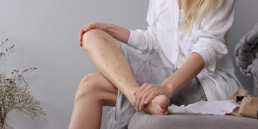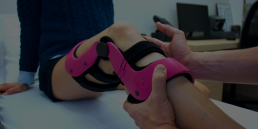For some time now, have you been feeling discomfort in the kneecap of your knee, or when your knee is bent? Do you suffer from stiffness or swelling in the knee that intensifies with certain movements? This may be a sign that you have osteoarthritis of the knee. Also called gonarthrosis, this pathology is the most common form of joint inflammation. It is mainly explained by the degeneration of the articular cartilage and can, in the long run, become disabling in daily life.
Find out now what the symptoms of osteoarthritis of the knee are, and the different causes that lead to this disease.
The first symptoms of osteoarthritis of the knee
The different types of pain
Certain signs may alert you, especially when the pain persists and intensifies:
- You have pain and discomfort when you move your knee movements: walking, running, squatting, kneeling or even going up and down stairs are difficult and painful;
- You find that your knees are more swollen and rounded than usual: the synovial membrane of the knee might be irritated by cartilage debris;
- Your knees creak, give way under your weight and tend to lock up when you make certain movements;
- You feel muscle weakness and loss around the knee area;
- You feel the bones in your knee rubbing together when you walk. This can then lead to bone growth.
When the pain appears
The symptoms of osteoarthritis of the knee are pain, cracking and swelling. They can vary according to the stress on the area during your daily activities, or the physical efforts made during the day.
There is a peak of discomfort in the evening due to an accumulation of cartilage debris, as well as stiffness in the morning. However, you will have some relief when you are resting, sitting or sleeping, as the joints are less stressed.
Do not hesitate to consult a doctor when you notice increasingly uncomfortable symptoms. He or she can recommend simple exercises, as well as anti-inflammatory drugs to relieve the pain. In other situations, infiltrations or knee surgery may also be considered. The latter allows you to replace your knee with a prosthesis, and thus relieve your pain.
The degeneration of articular cartilage, the main cause of osteoarthritis
The role and composition of the joint
It is the joint that allows the knee to perform its movements, to make you walk, run, jump etc. The joint is made up of two bony ends, covered with cartilage, that meet and articulate. The joint is delimited by a fibrous envelope, the capsule, covered by the synovial membrane which produces the synovial fluid. This is responsible for nourishing and lubricating the cartilage. Around the joint, there are ligaments and muscles attached to the bones by tendons.
Cartilage renewal
Cartilage is a living tissue that is constantly renewed every 3 months, even in the elderly. During this “moult”, fragments and debris of cartilage are dispersed within the joint cavity. The synovial membrane plays an important role in the renewal of the cartilage, as it cleans the cavity of debris, while secreting a substance that lubricates and nourishes the joint.
However, this well-functioning system can sometimes run out of steam, and cartilage damage can occur. This is a phenomenon that can be permanently cured in very young people, as their healing capacity is more efficient. However, when the subject is older (the risk of developing osteoarthritis increases with age, especially after 50), it is more difficult for the body to repair these lesions. The osteoarthritis will then worsen and lead to a more important loss of cartilage in the knee bone.
The different inflammations of osteoarthritis of the knee
Now that we have highlighted the different symptoms, it is time to know the different causes of knee pain.
Why does it become more difficult to perform certain movements?
Osteoarthritis is disabling in the realization of some of our daily movements, sometimes the most basic ones. When pain and inflammation are too strong, the nervous system “protects” the body by slowing down certain joint movements. It is thanks to this brilliant unconscious reflex that our body is protected from intense pain and injury. But it also leads to the inhibition of certain movements.
What causes swelling in the knee joint?
Again, the inflammation you feel is a defense mechanism of the body. When you have an imbalance such as osteoarthritis of the knee, the body compensates for the pain by sending out more cells, such as white blood cells, to deal with the pain and imbalance.
Another explanation for knee swelling is irritation of the synovial membrane due to cartilage debris. To reduce this irritation, the production of intra-articular lubricant, called synovial fluid, increases. The amount of fluid in the knee can then become very large, causing swelling.
What causes stiffness in the knee?
Stiffness in the muscles and the knee tends to occur mostly at rest. Indeed, when the knee is in extension, certain components of the inflammatory fluid are deposited on the tissues, hence the stiffness of the joint. When we start to activate and the knee is in flexion, the first movements are more painful than usual. However, as the knee warms up, the pain decreases.
Where does the rubbing sensation come from?
As stated above, osteoarthritis is mainly a degeneration of the cartilage of the knee joint. As this cartilage becomes thinner and thinner and as the synovial fluid becomes scarcer, the whole area of the joint becomes more vulnerable and sensitive to pressure and friction.
Things to remember
The knee is one of the joints of the body that absorb the most pressure during our daily movements. These small impacts and repeated traumas over several decades often bring different symptoms, such as knee pain. Over the long term, you may experience several symptoms of knee osteoarthritis:
- Stiffness, swelling and joint pain;
- Weakness of the muscles and the area;
- Difficulty performing certain movements.
Rest assured, osteoarthritis is a condition that can be alleviated with the right orthopedic treatments, particularly with the help of a knee brace or a splint. The EVO laboratory, an orthopedic specialist in the Eastern Townships and in Montreal, will help you reduce your discomfort related to osteoarthritis, and help you recover your mobility and vitality.
Visit our website now, and discover EVO’s solutions!
Relieve osteoarthritis of the knee with an orthosis
New treatments for osteoarthritis of the knee
Share this article
Related posts
July 20 2021
How to identify poor blood circulation?
June 15 2021
How to prevent venous insufficiency?
December 6 2019


